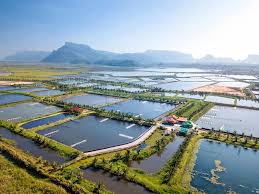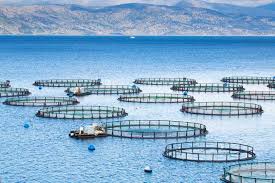Aquaculture is a distinct commercial activity that has provided an excellent response to the global demand for fish and seafood through the nutritious and affordable source of animal protein.
The technique not only facilitates the domestication of fish but also guarantees optimum fish health and high-quality fish products through good feeding and care of cultivated fish, as well as the sustainable harvest of fish of various types.
Objectives of Aquaculture;
1. To increase fish production, and consequent protein intake;
2. To stock waters that are heavily depleted of their natural resource through pollution, over-fishing, and high predation of offsprings;
3. For the production of fishing baits for commercial, and industrial fisheries sector;
4. Production of fishing species population for ornamental purposes; and
5. For large-scale production of miscellaneous fish species for industrial purposes e.g. fish meal, fish flour, etc.
Aquaculture (Aqua farming) as a Fisheries Technique

Aquaculture is the cultivation (farming) of the natural produce of water such as fish, shellfish, algae, and other aquatic organisms in fresh or salt water. It is distinguished from fishing by the idea of active human effort in maintaining or increasing the number of organisms involved, as opposed to simply taking them from the wild.
Economically, aquaculture is restricted to practices such as broodstock maturation, larval rearing, fingerling production, research animal production, specific pathogen-free (SPF) animal production, and caviar and ornamental fish production.
Aquaculture methods include Mariculture (aquaculture in the ocean), Algaculture (the production of kelp/seaweed and other algae), Fish Farming (the raising of catfish, tilapia, and milkfish in fresh water and brackish ponds or salmon in marine ponds) and the growing of cultured pearls. In 2003, aquaculture contributed about 31% of the total world production of fisheries products.
The growth rate of aquaculture is very rapid, higher than 10% per year for most species, compared to the flat contribution of wild fisheries to total production. Aquaculture minimizes environmental damage due to fishing through the use of a recirculating system (RAS), a series of culture tanks, and filters where water is continuously recycled.
Water is treated mechanically through the removal of particulate matter and biologically through the conversion of harmful accumulated chemicals into non-toxic ones to prevent the deterioration of water quality. Optimum water quality is maintained through UV sterilization, ozonation, and oxygen injection, thereby increasing the efficiency of feed utilization and the growth of fish.
Aquaculture also minimizes escaped fish, water usage, and the introduction of harmful pollutants. A drawback of aquaculture is water exchange, which can, however, be reduced through aquaponics such as the incorporation of hydroponically-grown plants and denitrification.
Read Also: The Principles of Proper Livestock Management
Types of Aquaculture
Aquaculture can be intensive, semi-intensive, or extensive, depending on the inputs (liming, fertilizer application, stocking, management) applied. It may involve stocking a single species of fish in a pond (monoculture) or culturing/stocking different species of fish in ponds (polyculture).
The criteria for selecting the fish species to stock are local availability, ability to live and breed in confinement (captivity), ability to efficiently convert food to the flesh, relative freedom and resistance to parasites and diseases, and recognition and acceptance as food fish and high market value.
The types of fish in aquaculture are tilapia (Tilapia Zilli, Oreochromis niloticus), cod, trout (e.g. Rainbow trout), Atlantic salmon, catfish (Cyrysichthys nigrodigitans), mud catfish (Clarias gariepinus, Heterobranchus bidorsalis), moonfish (Citharius citharius), African bony tongue (Heterotis niloticus), Niger/Nile perch (Lates niloticus), Snake head (Chana Obscura), mormyrid (Gymnarchus niloticus), milkfish, common carp, mudfish, gourami, Asian carp, silver carp, bighead carp, black carp, grass carp, shellfish, and catla.
1. Intensive (Closed-Circulation) Aquaculture
This involves the use of a network of circulation systems in culturing fish.
2. Extensive (Pond) Aquaculture
Available food supplies are from natural sources. Zooplankton feeding on pelagic algae or benthic animals such as crustaceans and mollusks is limited.
Specific Types within Intensive and Extensive Aquaculture Include;
1. Integrated recycling systems- involving the use of large plastic fish tanks in a glasshouse with a hydroponic bed placed near, above, or between the tanks;
2. Irrigation ditch or pond systems- the use of irrigation ditches or farm ponds to raise fish;
3. Cage system- the use of synthetic fibre cages to raise fish in rivers, lakes, filled quarries, etc.;
4. Classic fry farming- the use of fry or fingerlings to raise trout and other sports fish.
Read Also: The Economic Importance of Fish to Man
Read Also: What You Should Know Before Venturing Into Fruit Farming

